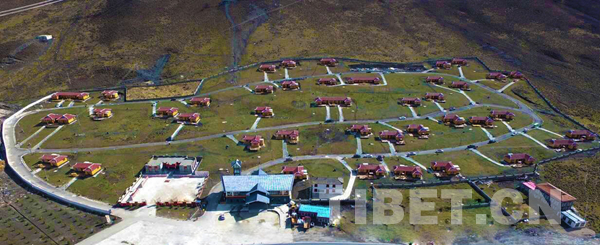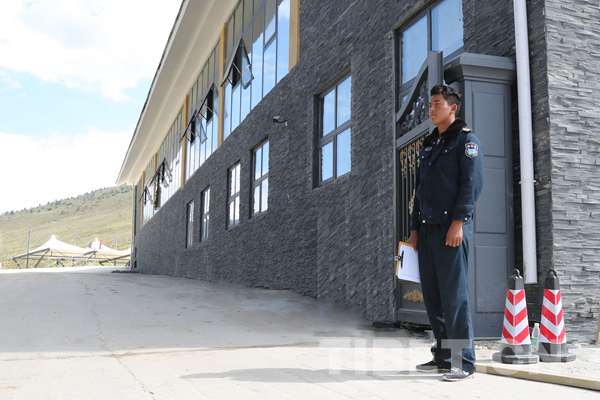Eda Menpa's major shift (III): Resources Now Seen as Assets
Editor's note: The Sichuan-Tibet Plateau, a beautiful region that reaches toward the heavens, is a place showered with blue skies, covered in white clouds, and dotted with snow-covered mountains, but recently, something truly remarkable has been materializing among the households that call this place home. A groundbreaking historic change has been reshaping the land and its people. From today on, we will publish a series of stories to tell you those changes.
Just as rivers and valleys can quickly turn into grassland when travelling, the village’s nomadic life has shifted to something completely foreign and new. Tents and mud houses have turned into bright and spacious brick structures, and all of this has happened in the blink of an eye. The red rooves and white walls are a pleasant accompaniment to the neat and clean asphalt roads, and today, perhaps one of the most difficult challenges for locals is trying to figure out how to furnish and redecorate everything. Laughter pours out from inside each structure. The five-year plan has helped the people tremendously, but it still requires the participation of major marketing entities and resources to be used as assets in order to be considered a true and final success.
Today, Tashi, a herder, has already taken his yaks out to graze and is now returning to his new home to drink some butter tea.
Muya Zeduo has leased 49 unoccupied houses to herders through a package program. Each house is equipped with advanced electric appliances and bathroom facilities, and when talking with him about what he thinks, Tashi does not hesitate to say, “Our lives today are nothing like they used to be. I first leased my own house to the company, and since they redecorated everything, I am now earning money just to stay at home!” The company is supported by the government in its efforts to promote the Muya culture centered at Eda Menpa, and so it renovated the previously substandard houses into inns for tourists. Parking lots and vehicle service areas are now offered to people driving along the nearby highway, and shops selling Tibetan specialties are scattered here and there along the road. Everything is done through the village collective.
The tourist attraction uses a tri-part cooperative model as its basis, with the three points being the government, company, and village. Tourism allows the locals to target poverty head on, and projects centered on poverty relief bring the advantages of local culture and nearby resources together as part of one formulated plan. The venue itself includes the Muya town, a tourist service center, family-based inns, roads, and observation decks. To maximize profits for villagers, local labor is used throughout the entire construction process. In 2015 alone, there was a total of 360 thousand yuan earned by casual laborers, with the village transportation team earning a total of 750 thousand.
To balance local resource development and the pragmatic profits of local villagers, Muya Zeduo puts forward 400 thousand yuan each year to purchase medical insurance for herders living in Eda Menpa, and also provides pensions for elderly villagers so that these villagers do not have to worry about their futures and can focus more on doing what they can to improve the local attraction. There is also heavy emphasis put on training local talents, particularly from the younger generations, to prepare them to undertake administrative and managerial positions within nearby businesses and also provide them with the knowledge and skills needed to function better within the tourism industry. In October 2015, the United Front Work Department of Sichuan Province coordinated with the Chinese Vocational Education Society (Sichuan branch) to hold a one-month tourism training program, which included training in speaking Mandarin Chinese and professional advice regarding tourism, all ending with a two-year follow-up program. These initiatives aimed to equip poverty-stricken villagers with the tools necessary to generate wealth while also enjoying bonuses from shared resources. To date, 48 herders have already been employed, and the idea that one person can be employed and bring his or her family out of poverty has become an attainable reality.
Despite the close connection between benefits and the poverty-relief mechanism, a great number of restrictions have been issued to prevent inappropriate behavior. Enterprises are requested to have at least 40% of employees be local villagers, and no matter how well business is going (or not going), each company must pay a fixed basic bonus according to a set schedule. Still, though, villagers are not able to build new houses or temporary buildings unless they first get permission from their enterprises, and villagers must successfully complete training before obtaining permission to be formally employed.
The development of a tourist venue must always be connected with whatever traditional industries may be available in the local area. This particular cooperative has therefore taken yak wool and set up a core industry centered around the processing of related products. “Industry-oriented, leader-driven!” has been the main motto that allowed the village to tap into Sichuan Lanyi Group, the main industrial dairy enterprise in the area. With a systematic purchasing, transport, and sales chain via milk stations and milk bars, villagers’ incomes are now skyrocketing as yet another local resource has been turned into an asset.
The Chinese version of this story is written by Zhuhong & Zhouyu and translated into English by Huang Wenjuan. And the story is sourced from the United Front Work Deparment of the Communist Party of China (CPC)Sichuan Provincial Committee.
Your Comment
Name E-mailRelated News
-
;
-
-
-
Eda Menpa's major shift (II): From Herders to Shareholders
To be better off as a society, locals had to look for a hand up to get out of their critical situation and eventually adopted initiatives presented through targeted poverty-relief projects.
-
-
-

-
A tapestry of achievement: Eda Menpa's major shift (I)
From a poor village to a tourist hub and from being impoverished to becoming shareholders, how is it that Eda Menpa and its people have attained such great success?
-
Based in Lhasa, Tibet Vista is a Tibet travel agency that specialized in Tibet permit, and Tibet tours for both private and group travelers at a local price!
•4 Days Lhasa City Group Tour from USD 460 •8 Days Everest Base Camp Group Tour from USD 850 •15 Days Mt.Kailash Group Tour from USD 1780 •2016 Tibet Train Tours from Beijing, Shanghai, Chengdu, Xining,etc











